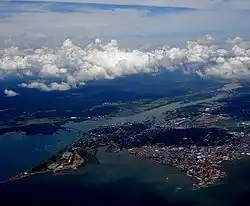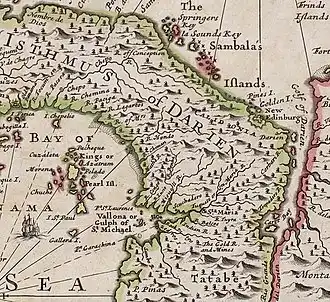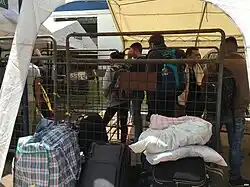The Darien Gap crossings are migratory crossings which have been made over the centuries via the Darien Gap, a narrow neck of land where Central America meets South America. People who are engaged in migration have crossed the Darien Gap in large numbers at various times over the last several hundred years, although resort to the land crossing declined for much of the twentieth century as a result of the opening of the Panama Canal. It has experienced a resurgence in recent decades, particularly so as migrant crises have developed in countries like Colombia and Venezuela. The Darien Gap crossing is known as a particularly treacherous migratory route, as the narrow neck of land between Colombia and Panama is a region of dense tropical forests and swamps that are rife with diseases and perilous to travel through. Nevertheless, this is one of the world’s great migratory routes, connecting the two American continents. Tens of millions of people worldwide today will have an ancestor who has crossed the Darien Gap in one way or another in times gone by.[1]
Research your ancestors on MyHeritage
Darien Gap crossings chronology of eventsDarien Gap crossings chronology of events
The Darien Gap refers to the region around where Central America connects to South America. As such, it is the meeting point of two continents, North and South America, and also the narrowest crossing point by land from the Atlantic Ocean to the Pacific Ocean. Most of the Gap lies in Panama, but some of it is located inside Colombia. It is a densely forested region and the region has historically been rife with tropical diseases, especially for travellers from Europe or North America who are unaccustomed to the conditions here. In a broader sense when we refer to crossing the Darien Gap it can be viewed as historical efforts to transit across the Isthmus of Panama from the Caribbean Sea to the Gulf of Panama.[2]

One of the eras in which the Darien Gap experienced its greatest level of migration was during the California Gold Rush of the late 1840s and early 1850s. Gold was struck in California in 1848, almost exactly at the same time as the end of the Mexican-American War (1846–1848) led to Mexico ceding a vast amount of territory to the United States, including the region covering the modern-day states of New Mexico, Arizona, Nevada, California and southern Oregon. Tens of thousands of people quickly set off westwards for California to join the gold rush, but, unlike what most western films would have us believe, not everyone headed out west by land in an age where there were no railways in this part of the world. Many went by sea, a faster and safer way of travelling. Some headed all the way south to Cape Horn at the southern end of South America and then came all the way back north to California, but others cut the journey in half by travelling as far as Panama, then disembarking and travelling across the Darien Gap from the Caribbean Sea to the Gulf of Panama and then taking ship again northwards to California.[3]
The passage of individuals across the Darien Gap in the middle of the nineteenth century reignited interest in carving a canal in the region that would allow for ships to pass straight through. Inspired by the completion of the Suez Canal in Egypt and after many false starts in Central America, work on what became the Panama Canal eventually began in the 1880s. It was a slow and costly process for the French engineers that commenced it, with disease outbreaks hampering the process. The project was only completed after the US government largely took over the project at the start of the twentieth century. Once the Panama Canal finally opened for traffic in 1914, it severely minimized the amount of land traffic going across the Darien Gap either north-south or east-west for much of the remainder of the twentieth century.[4]
The Darien Gap became a major transit route again in the late twentieth century. Political instability and economic crises in South America resulted in hundreds of thousands and then millions of people deciding to literally begin travelling on foot from South America across the Darien Gap and then onwards towards Mexico and the United States. At a time when marine and aerial travel into the United States have become heavily monitored, the perilous Darien Gap route has become one of the best means available for many to flee from the perils of South America.[5] This has especially been the case for Colombians fleeing the violence of the long-running Colombian armed conflict and Venezuelans departing their country as a result of the catastrophic economic collapse of the country and hyperinflation there since the early 2010s. As all of this has occurred, the Darien Gap has become a major refugee and migrant route again in recent years.[6]
Extent of migration across the Darien GapExtent of migration across the Darien Gap

There has been a steady stream of people crossing the Darien Gap for centuries. Peru was one of the core parts of Spain’s colonial empire and rather than sailing around South America and voyaging through the Straits of Magellan or around Cape Horn, a perilous voyage in its own right, methods were established for Spanish travellers to take ship to Panama, then cross the isthmus and sail onwards for Lima and other locations. The traffic swelled at particular times, notably during the California Gold Rush when thousands of people crossed the region.[7] Throughout the era of the American West and of mass European immigration to the Americas in the late nineteenth and early twentieth centuries, companies operated here that specifically provided transport for people to Central America, across the Darien Gap and then northwards to places like San Diego and San Francisco. Thus, although accurate figures cannot be ascertained, as they were not recorded systematically over time, hundreds of thousands of people clearly crossed the Darien Gap between the sixteenth and early twentieth centuries to settle in places like Peru and California.[8]
Equally, trying to determine how many people have crossed the Darien Gap in recent times involves a lot of guesswork, as the Panamanian government only began recording the number of people transiting through here in 2010. By then hundreds of thousands of people had probably passed through unrecorded in the century since the opening of the Panama Canal. The numbers remained modest for several years after recording began. They averaged 2,400 crossings per year between 2010 and 2014, but then as the hyperinflation crisis and economic collapse in Venezuela escalated, things ticked upwards. 30,000 migrants crossed the Darien Gap in 2015 and a similar number in 2016. That number doubled by 2021, it exceeded 150,000 in 2022 and nearly 210,000 people crossed through the narrow neck of land between January and August 2023. The primary nationalities are Venezuelans, Ecuadorians and Haitians, while large numbers of people from Asia have also been recorded in recent years.[9]
Demographic impact of the Darien Gap crossingsDemographic impact of the Darien Gap crossings

Over a broad period of time, the migration across and over the Darien Gap has led to major demographic changes in many countries and regions. Some of these lie thousands of kilometers away from the Gap itself. For instance, when the Darien Gap crossings attendant on the California Gold Rush began in the late 1840s, there was an estimated 95,000 people living in California and most of these were natives or colonials of Spanish ancestry. By 1860 the population had swelled to over 300,000 and it reached the one million mark in the early 1880s. The Darien Gap crossings of the ‘48ers played a substantial role in creating this demographic boom in the south-western state.[10]
More recently the primary impact has been felt across Central America and Mexico. Millions of people have crossed the Darien Gap, either recorded or unrecorded, since 2010 and these are leading to a growth in the Latin American community in the Sun Belt region of the United States and in Mexico and the smaller Central American states. For instance, the Venezuelan American community has grown very substantially in recent years. In decades to come many people in the United States will be able to trace their ancestry to a relative who migrated across the Darien Gap to Central America and onwards to the United States during the 2010s and 2020s. As such, the demographic impact of the Darien Gap crossings is an ongoing story.[11]
See alsoSee also
Explore more about the Darien Gap crossingsExplore more about the Darien Gap crossings
- Colombia, Baptisms, 1630-1950 records collection on MyHeritage
- Colombia, Marriages, 1750-1960 records collection on MyHeritage
- Venezuela Voter Lists, 2006-2007 records collection on MyHeritage
- Ecuador, Baptisms, 1680-1930 records collection on MyHeritage
- Ecuador, Marriages, 1680-1930 records collection on MyHeritage
- 1852 California State Census records collection on MyHeritage
- California Newspapers, 1847-2009 records collection on MyHeritage
- California, Great Registers, 1866-1910 records collection on MyHeritage
- ↑ https://www.hrw.org/news/2023/10/10/how-treacherous-darien-gap-became-migration-crossroads-americas
- ↑ https://programs.wcs.org/5greatforests/Wild-Places/Darien
- ↑ Aims McGuinness, Path of Empire: Panama and the California Gold Rush (Ithaca, 2008).
- ↑ https://www.history.com/topics/landmarks/panama-canal
- ↑ https://www.cfr.org/article/crossing-darien-gap-migrants-risk-death-journey-us
- ↑ https://www.hrw.org/news/2023/10/10/how-treacherous-darien-gap-became-migration-crossroads-americas
- ↑ John Haskell Kemble, ‘The Gold Rush by Panama, 1848–1851’, in Pacific Historical Review, Vol. 18, No. 1: Rushing for Gold (February, 1949), pp. 45–56.
- ↑ https://www.lindahall.org/experience/digital-exhibitions/the-land-divided-the-world-united/04-prelude-to-the-railroad/
- ↑ https://www.hrw.org/news/2023/10/10/how-treacherous-darien-gap-became-migration-crossroads-americas
- ↑ https://explore.museumca.org/goldrush/curriculum/1stcalifornians/resourcesix.htm
- ↑ https://www.thenewhumanitarian.org/maps-and-graphics/2024/01/15/darien-gap-migration-crisis-six-graphs-and-one-map

